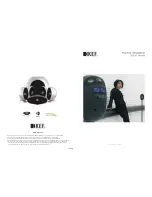
If the wirefeeder is attached to a crane holder during welding, always use a suitable, in-
sulated wirefeeder hoisting attachment (MIG/MAG and TIG devices).
If the device has a carrying strap or handle, this is intended solely for carrying by hand.
The carrying strap is not to be used if transporting with a crane, counterbalanced lift truck
or other mechanical hoist.
All lifting tackle (straps, handles, chains, etc.) used in connection with the device or its
components must be tested regularly (e.g. for mechanical damage, corrosion or changes
caused by other environmental factors).
The testing interval and scope of testing must comply with applicable national standards
and directives as a minimum.
Odourless and colourless shielding gas may escape unnoticed if an adapter is used for
the shielding gas connection. Prior to assembly, seal the device-side thread of the ad-
apter for the shielding gas connection using suitable Teflon tape.
Requirement for
the shielding gas
Especially with ring lines, contaminated shielding gas can cause damage to equipment
and reduce welding quality.
Meet the following requirements regarding shielding gas quality:
-
Solid particle size < 40 µm
-
Pressure condensation point < -20 °C
-
Max. oil content < 25 mg/m³
Use filters if necessary.
Danger from
shielding gas cyl-
inders
Shielding gas cylinders contain gas under pressure and can explode if damaged. As the
shielding gas cylinders are part of the welding equipment, they must be handled with the
greatest of care.
Protect shielding gas cylinders containing compressed gas from excessive heat, mech-
anical impact, slag, naked flames, sparks and arcs.
Mount the shielding gas cylinders vertically and secure according to instructions to pre-
vent them falling over.
Keep the shielding gas cylinders well away from any welding or other electrical circuits.
Never hang a welding torch on a shielding gas cylinder.
Never touch a shielding gas cylinder with an electrode.
Risk of explosion - never attempt to weld a pressurised shielding gas cylinder.
Only use shielding gas cylinders suitable for the application in hand, along with the cor-
rect and appropriate accessories (regulator, hoses and fittings). Only use shielding gas
cylinders and accessories that are in good condition.
Turn your face to one side when opening the valve of a shielding gas cylinder.
Close the shielding gas cylinder valve if no welding is taking place.
If the shielding gas cylinder is not connected, leave the valve cap in place on the cylin-
der.
The manufacturer's instructions must be observed as well as applicable national and in-
ternational regulations for shielding gas cylinders and accessories.
12
Summary of Contents for WF 15i
Page 2: ......
Page 16: ...16...
Page 17: ...General 17...
Page 18: ...18...
Page 21: ...Controls connections and mechan ical components 21...
Page 22: ...22...
Page 29: ...OPT i WF Stand ard control panel 1 9 8 5 6 10 11 12 2 3 4 7 14 13 29 EN...
Page 34: ...34...
Page 35: ...Installation and commissioning 35...
Page 36: ...36...
Page 41: ...2 41 EN...
Page 54: ...54...
Page 55: ...Troubleshooting maintenance and disposal 55...
Page 56: ...56...
Page 63: ...Technical data 63...
Page 64: ...64...
Page 69: ...69 EN...
Page 70: ...70...
Page 71: ...71 EN...













































